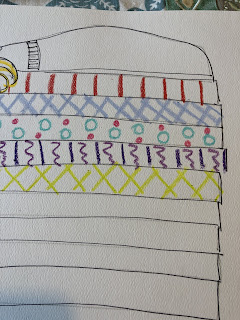Welcome to a New Year of Art fun!! After a COVID year of teaching from a cart, I am SUPER excited to be returning to my classroom space! Let me take you on a tour of my revamped and redecorated classroom.
What room decoration and welcome would be complete without a welcoming entrance? I think the kids will be excited to enter! For those of you who are hanging-challenged with cinder block walls like mine, may I recommend the heavy-duty Command Strips. I wiped down all the surfaces with Clorox wipes, dried them with paper towels, and then attached the Command Strips. MAGIC! So far only one picture has fallen, though these crosses may be tested as students rub along the walls (fingers crossed).
As you can see, inspiration abounds in this space. I can honestly say that if there is an empty space, I have attached some kind of art to it. I collect pieces to inspire my students from travels, thrift shops, local artists, former students, and eBay, as well as my own art. In the front of my room, I showcase the Elements of Art.
The Artist Oath and the A-R-T volume control posters are clearly visible over the whiteboard. Teaching in a Catholic School we begin every class with a prayer (framed and hung above the whiteboard). All 3 of these pieces are important for consistency throughout all of my classes (K-8th). This year I will be adding PreK back into the mix, but I will be traveling across the campus to see them in their own space. It won't be as overwhelming size-wise for them. I look forward to them becoming Kindergarteners next year and coming into my space 💜
Continuing the tour around the room we pass by my desk (decorated of course). The drying racks are ready for art projects to fill them. Artwork (new and old pieces) line each divider between the windows (again, thank goodness for Command strips!). I'm anxious to see how observant my students will be.
This year we will have desks instead of tables, to accommodate distancing rules. So far they are stacked in the center of the room but should be laid out soon. Along this wall, you can see my new printmaking station, filled with brayers and awaiting the carving tools from my wishlist (more about that later). The bunged-up green cabinets have been repainted to start the year fresh.
My brother's panoramic photo of bison in Yellowstone has moved from above the bulletin board paper rolls to above the door. I think it is a much better fit! The clock which disappeared last year is now safely back in place (it was a bit of a distraction last year).
New art has been hung over the bulletin board paper: a handmade and embossed triptych that I found at a thrift shop and will use as inspiration as we make our own handmade paper AND a painting done by a young Russian artist who is disabled (I bought this one specifically to show that anything is possible as long as you try).
That brings me back to my printing station and my wishlist. I have created an Amazon wishlist in hopes that I can accumulate enough tools to teach my older students relief printing and how to create their own carved blocks. The yellow bins will house the tools as they are accumulated. If you would like to help stock my classroom, please follow the link below to my wishlist...and THANK YOU in advance 😁
I'm looking forward to a great 2021-22 school year!






















































